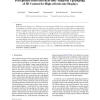Free Online Productivity Tools
i2Speak
i2Symbol
i2OCR
iTex2Img
iWeb2Print
iWeb2Shot
i2Type
iPdf2Split
iPdf2Merge
i2Bopomofo
i2Arabic
i2Style
i2Image
i2PDF
iLatex2Rtf
Sci2ools
EUROGRAPHICS
2010
Eurographics
2010
Eurographics
Perceptually-motivated Real-time Temporal Upsampling of 3D Content for High-refresh-rate Displays
High-refresh-rate displays (e. g., 120 Hz) have recently become available on the consumer market and quickly gain on popularity. One of their aims is to reduce the perceived blur created by moving objects that are tracked by the human eye. However, an improvement is only achieved if the video stream is produced at the same high refresh rate (i. e. 120 Hz). Some devices, such as LCD TVs, solve this problem by converting low-refresh-rate content (i. e. 50 Hz PAL) into a higher temporal resolution (i. e. 200 Hz) based on two-dimensional optical flow. In our approach, we will show how rendered three-dimensional images produced by recent graphics hardware can be up-sampled more efficiently resulting in higher quality at the same time. Our algorithm relies on several perceptual findings and preserves the naturalness of the original sequence. A psychophysical study validates our approach and illustrates that temporally up-sampled video streams are preferred over the standard low-rate inpu...
| Added | 11 Mar 2010 |
| Updated | 15 Mar 2010 |
| Type | Conference |
| Year | 2010 |
| Where | EUROGRAPHICS |
| Authors | Piotr Didyk, Elmar Eisemann, Tobias Ritschel, Karol Myszkowski, Hans-Peter Seidel |
Comments (0)

